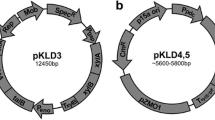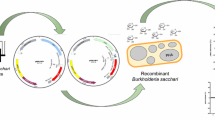Abstract
Three xylose-fermenting recombinant Zymomonas mobilis strains containing different Peno-talB/tktA operon terminators were engineered. Each showed similar levels of foreign protein expression and xylose fermentation performance. Strain CP4-P2-1 was further used to compare the glucose/xylose co-fermentation under various cultivation environments to improve the efficiency of the process. Optimal co-fermentation was achieved at 30–34 °C and pH 5.5 using xylose-grown preculture cells giving 20.5 g ethanol/l, ethanol productivity of 0.43 g/l h and ethanol yield of 0.44 g/g at 48 h. Adverse culture conditions mainly influenced the efficiency of xylose fermentation but not glucose fermentation. The key factors affecting co-fermentation were also explored at the molecular level. This study provides valuable insights into the effective harnessing of biomass resources.





Similar content being viewed by others
References
Agrawal M, Mao Z, Chen RR (2011) Adaptation yields a highly efficient xylose-fermenting Zymomonas mobilis strain. Biotechnol Bioeng 108:777–785. doi:10.1002/bit.23021
Altintas MM, Eddy CK, Zhang M, McMillan JD, Kompala DS (2006) Kinetic modeling to optimize pentose fermentation in Zymomonas mobilis. Biotechnol Bioeng 94:273–295. doi:10.1002/bit.20843
Bajpai PK, Margaritis A (1986) Effect of temperature and pH on immobilized Zymomonas mobilis for continuous production of ethanol. Biotechnol Bioeng 28:824–828. doi:10.1002/bit.260280608
Cazetta ML, Celligoi MAPC, Buzato JB, Scarmino IS (2007) Fermentation of molasses by Zymomonas mobilis: effects of temperature and sugar concentration on ethanol production. Bioresour Technol 98:2824–2828. doi:10.1016/j.biortech.2006.08.026
Gao Q, Zhang M, McMillan JD, Kompala DS (2002) Characterization of heterologous and native enzyme activity profiles in metabolically engineered Zymomonas mobilis strains during batch fermentation of glucose and xylose mixtures. Appl Biochem Biotechnol 98–100:341–355. doi:10.1385/ABAB:98-100:1-9:341
Jeon YJ, Svenson CJ, Rogers PL (2005) Over-expression of xylulokinase in a xylose-metabolising recombinant strain of Zymomonas mobilis. FEMS Microbiol Lett 244:85–92. doi:S0378-1097(05)00039-X
Joachimsthal EL, Rogers PL (2000) Characterization of a high-productivity recombinant strain of Zymomonas mobilis for ethanol production from glucose/xylose mixtures. Appl Biochem Biotechnol 84–86:343–356. doi:10.1385/ABAB:84-86:1-9:343
Kim IS, Barrow KD, Rogers PL (2000) Kinetic and nuclear magnetic resonance studies of xylose metabolism by recombinant Zymomonas mobilis ZM4 (pZB5). Appl Environ Microbiol 66:186–193. doi:10.1128/AEM.66.1.186-193.2000
King F, Hossain M (1982) The effect of temperature, pH, and initial glucose concentration on the kinetics of ethanol production by Zymomonas mobilis in batch fermentation. Biotechnol Lett 4:531–536. doi:10.1007/BF00131577
Lawford HG, Rousseau JD (2001) Fermentation performance assessment of a genomically integrated xylose-utilizing recombinant of Zymomonas mobilis 39676. Appl Biochem Biotechnol 91–93:117–131. doi:10.1385/ABAB:91-93:1-9:117
Okamoto T, Nakamura K (1992) Simple and highly efficient transformation method for Zymomonas mobilis: electroporation. Biosci Biotech Biochem 56:833. doi:10.1271/bbb.56.833
Panesar PS, Marwaha SS, Kennedy JF (2007) Comparison of ethanol and temperature tolerance of Zymomonas mobilis strain in glucose and molasses medium. Indian J Biotechnol 6:74–77
Rogers PL, Jeon YJ, Lee KJ, Lawford HG (2007) Zymomonas mobilis for fuel ethanol and higher value products. Biofuels 108:263–288. doi:10.1007/10_2007_060
Widiastuti H, Kim JY, Selvarasu S, Karimi IA, Kim H, Seo JS, Lee DY (2011) Genome-scale modeling and in silico analysis of ethanologenic bacteria Zymomonas mobilis. Biotechnol Bioeng 108:655–665. doi:10.1002/bit.22965
Yanase H, Sato D, Yamamoto K, Matsuda S, Yamamoto S, Okamoto K (2007) Genetic engineering of Zymobacter palmae for production of ethanol from xylose. Appl Environ Microbiol 73:2592–2599. doi:10.1128/AEM.02302-06
Zhang M, Eddy C, Deanda K, Finkelstein M, Picataggio S (1995) Metabolic engineering of a pentose metabolism pathway in ethanologenic Zymomonas mobilis. Science 267:240–243. doi:10.1126/science.267.5195.240
Author information
Authors and Affiliations
Corresponding author
Electronic supplementary material
Below is the link to the electronic supplementary material.
Rights and permissions
About this article
Cite this article
Ma, Y., Dong, H., Zou, S. et al. Comparison of glucose/xylose co-fermentation by recombinant Zymomonas mobilis under different genetic and environmental conditions. Biotechnol Lett 34, 1297–1304 (2012). https://doi.org/10.1007/s10529-012-0897-4
Received:
Accepted:
Published:
Issue Date:
DOI: https://doi.org/10.1007/s10529-012-0897-4




